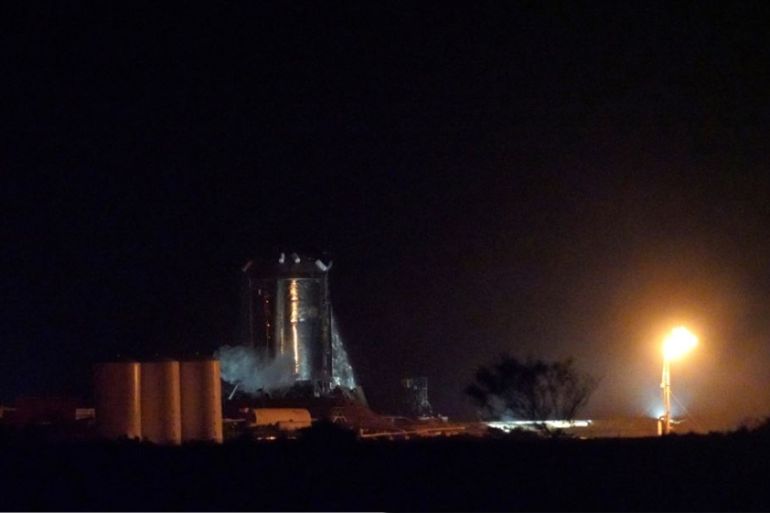SpaceX Starship Launch System: One small hop for Musk
The untethered lift-off is an early step for a 100-passenger spacecraft.

The SpaceX test vehicle Starhopper jumped untethered and flew sideways before landing at the test site near the beaches of Boca Chica, in Brownsville, Texas in the United States. The hope was to see the prototype jump 20 metres, but a massive fire cloud obscured the test, leaving observers wondering just how far the craft actually hopped.
Once the fire cloud dissipated, Starhopper was not only intact, but had definitely hopped from its original position. How far was difficult for observers – who were kept more than two-and-a-half kilometres away – to discern. Unlike the first untethered test, which was aborted, Thursday’s test was not livestreamed by SpaceX, which did not comment on it immediately afterwards.
Keep reading
list of 4 itemsHong Kong’s first monkey virus case – what do we know about the B virus?
Why will low birthrate in Europe trigger ‘Staggering social change’?
The Max Planck Society must end its unconditional support for Israel
But Elon Musk, SpaceX’s founder, tweeted seconds after the fire cloud cleared, “Starhopper flight successful. Water towers *can* fly haha!!”.
Starhopper flight successful. Water towers *can* fly haha!!
— Elon Musk (@elonmusk) July 26, 2019
Musk claims that within a “few months” – and equipped with its new Raptor engine – the prototype will be able to jump up to 20km.
The stainless steel Starhopper, which looks like the little brother of the spaceship mock-up used in the 1950 sci-fi classic film Destination Moon, is part of SpaceX’s Star Launch System development programme. Its flagship spacecraft will be the Starship – for which the Starhopper, equipped with just a single Raptor engine, is one of two competing initial prototypes.
SpaceX’s founder, Elon Musk, tweeted earlier this week that the Starship’s Super Heavy rocket will eventually consist of 35 Raptor engines. That power will be needed because the programme aims to develop an interplanetary two-stage spacecraft, capable of sending cargo or up to 100 people to the moon, Mars, and back to Earth.
The Starship’s maiden voyage with a crew to and around the moon is slated to take place sometime in 2023, the year before NASA intends to send a manned mission to the lunar South Pole. Last September, Musk introduced the world to Starship’s first private passenger, Yusaku Maezawa, a billionaire known for launching Japan’s largest online retail fashion outlet, Zozotown.
Maezawa, an ardent art collector, said he intends to take “a painter, musician, film director, fashion designer…” with him for a creative project called #dearMoon. After having made a “significant deposit” for his moon tickets, the billionaire this May auctioned some of his pieces, including Andy Wharhol’s white Flowers, because, according to his tweet, he needed the money.
SpaceX has also needed capital. It raised $1.3bn for Starship and its internet satellite network, Starlink, earlier this year. SpaceX is reportedly worth $33.3bn.
Reduce, reuse, return
The design vision is for the Star Launch System’s rocket fleet to be made up of completely reusable hardware, much like the private space company’s current lineup of Falcon 9 and Falcon Heavy rockets, which are all reusable.
Earlier on Thursday, SpaceX launched its 18th commercial cargo mission to the International Space Station using its reusable two-stage Falcon 9 rocket. The rocket, which is powered by Merlin engines, delivered SpaceX’s unmanned Dragon cargo ship into Low Earth Orbit, before returning to make a perfect landing at Cape Canaveral Air Force Station.
The initial prototype, called Hoppy by Brownsville locals and SpaceX watchers, experienced a hiccup on Thursday evening, with the launch team aborting just seconds into the test. Musk explained in a tweet today that the liquid methane and liquid oxygen that power the Raptor engine had been cooler than expected, forcing the test team to abort.
Starhopper is one of two Starship prototypes, with the other being located in Cocoa, Florida. SpaceX has not revealed when testing for that yet-to-be-named craft will begin.